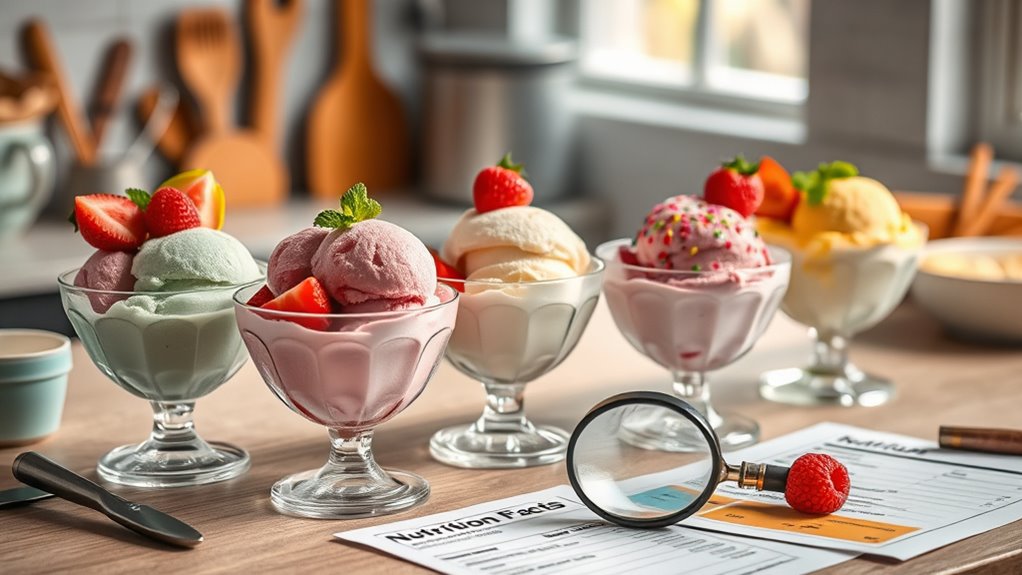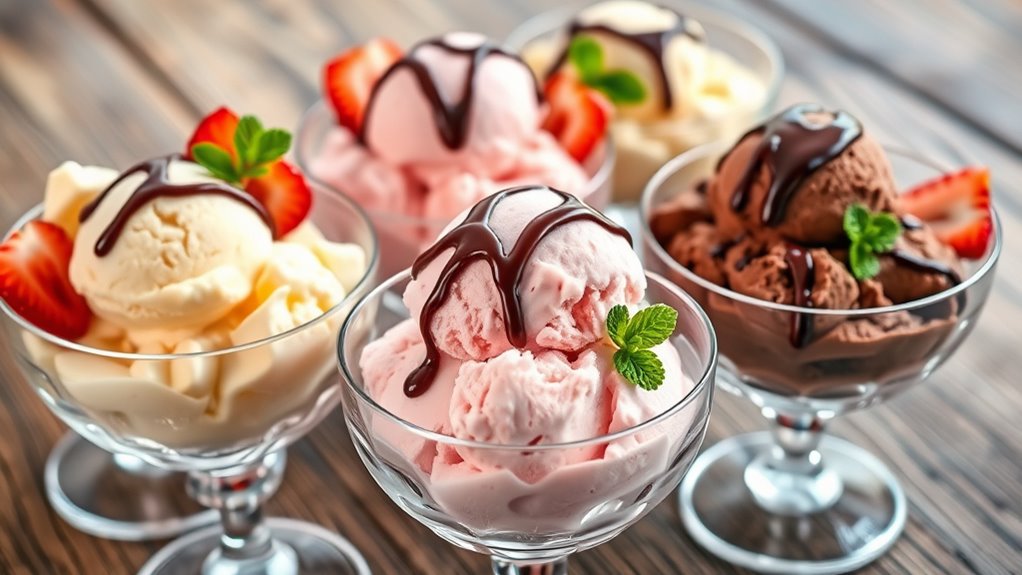Low-calorie ice creams are definitely reality! They let you satisfy your sweet cravings without wrecking your health goals. Made with ingredients like Greek yogurt and natural sweeteners, they pack fewer calories and less fat than traditional ice creams. However, some low-calorie options may lack creaminess or taste, and consumer reactions can vary. To make smart choices, check nutrition labels and ingredients. Want to know more about how to navigate the options out there?
Key Takeaways
- Low-calorie ice creams typically contain fewer than 150 calories per serving, making them a reality for guilt-free indulgence.
- Ingredients like frozen bananas, Greek yogurt, and erythritol contribute to lower calorie counts without sacrificing flavor.
- While they offer fewer calories, low-calorie options may sacrifice creaminess compared to traditional ice creams.
- The rise in health consciousness has sparked innovative flavors and formulations, boosting the popularity of low-calorie ice creams.
- Portion control and mindful eating are essential for enjoying low-calorie treats while maintaining health goals.
Understanding Low-Calorie Ice Creams

Have you ever wondered what makes low-calorie ice creams a popular choice for those looking to indulge without the guilt?
These treats often use ingredients like bananas for natural sweetness and Greek yogurt or non-dairy alternatives, providing a creamy base with less fat. Erythritol, a sugar alcohol, helps cut calories without sacrificing flavor. In fact, the rise in vegan and dairy-free ice cream options reflects consumer demand for healthier alternatives. Many of these options also include frozen yogurt as a lighter alternative to traditional ice cream. Including a balance of protein in your diet can enhance satisfaction and help maintain energy levels throughout the day. Additionally, the popularity of Birthday Cake Ice Cream showcases how indulgent flavors can be reimagined in lower-calorie forms.
Rapid freezing techniques and air incorporation create that delightful, smooth texture we crave. You can whip up your own version with blenders or food processors, using stabilizers like guar gum to avoid icy clumps.
Brands like Halo Top and Enlightened capitalize on this trend, offering high-protein options that appeal to health-conscious consumers. Incorporating ingredients like Greek yogurt can significantly boost the protein content, making these ice creams even more satisfying.
But remember, moderation is key for enjoying these tasty alternatives!
Nutritional Breakdown: Traditional vs. Low-Calorie

When comparing traditional and low-calorie ice creams, you’ll notice notable differences in their nutritional profiles.
Traditional ice creams usually contain between 140 to 350 calories per serving, with 7 to 13 grams of total fat and high sugar content, often ranging from 12 to 25 grams. Regular consumption of these traditional options may contribute to health issues such as diabetes and heart disease. Additionally, high saturated fats in traditional ice cream can raise LDL cholesterol levels. Furthermore, high sugar content in traditional ice cream can lead to weight gain if consumed excessively.
In contrast, low-calorie options typically have fewer than 150 calories, around 5 grams of fat, and considerably reduced sugar levels, sometimes nearly zero. Additionally, some low-calorie varieties pack up to 20 grams of protein per serving, making them attractive for those seeking protein. The clean beauty segment is also rising, with consumers becoming more health-conscious about what they consume, including food products.
While traditional ice cream offers a richer, creamier texture due to higher fat content, low-calorie options may lack that indulgent experience but provide fewer calories overall. This trend towards healthier alternatives reflects a broader movement in food towards sustainability and eco-friendly decor choices, as consumers become more health-conscious.
Ingredients That Make a Difference

Low-calorie ice creams rely on unique ingredients to achieve their lighter profiles while still delivering a satisfying experience. Frozen bananas create a creamy texture, while Greek yogurt adds protein and smoothness. Incorporating chia seeds provides a rich source of dietary fiber, which can aid in digestion and enhance overall health benefits. Chia seeds are also known for their ability to promote satiety, helping to curb hunger and support weight loss. Additionally, chia seeds are a plant-based source of omega-3 fatty acids, making them an excellent addition for those looking to boost their nutritional intake.
Full-fat coconut milk offers richness without the calories, making it a popular choice. Natural sweeteners like erythritol and stevia allow you to enjoy sweetness without the guilt. Thickeners like guar gum and carrageenan enhance texture and stability, ensuring your treat feels indulgent. Additionally, incorporating chia seeds can elevate both flavor and nutritional value in your low-calorie ice cream. Flavor enhancers such as cocoa powder and vanilla extract boost taste without extra calories.
Healthier Alternatives to Consider

What healthier alternatives can satisfy your sweet tooth while keeping your calorie count in check?
Consider options like Greek yogurt with berries, which packs protein and probiotics. Incorporating natural materials into your diet can also enhance overall health and wellness. For instance, juices rich in vitamins A, C, and E can promote skin health alongside your dessert choices. Essential oils, such as peppermint oil, can provide refreshing flavors that elevate your homemade treats.
You might also enjoy homemade strawberry-banana ice cream made from pureed fruits for a natural sweetness.
For a creamy treat, try avocado ice cream—it’s dairy-free and delicious.
If you’re in the mood for something light, sorbet offers a revitalizing, fruit-based option.
Frozen bananas blended into a smooth texture can mimic traditional ice cream without the extra calories.
Finally, chia seed pudding made with almond milk provides a nutritious, low-calorie dessert. These alternatives can help you indulge without straying from your health goals.
Consumer Perception and Misunderstandings

Consumer perceptions of low-calorie ice creams are often clouded by misunderstandings and high expectations. You might think these treats will taste just as indulgent as traditional ice creams, but many find the flavor disappointing. Newborns typically sleep 14-17 hours a day, which can parallel the time you might spend exploring various ice cream options. Additionally, the lower fat content can lead to a lack of creaminess, similar to the texture issues found in celery juice due to its natural diuretic properties. Furthermore, many consumers are unaware that hydrocolloid technology used in skincare can enhance the texture and satisfaction of certain food products, similar to how it improves acne patches.
In fact, many low-calorie ice creams utilize fresh ingredients to create more flavorful alternatives. Texture can also be a letdown, with icier consistencies due to lower fat content. While you may seek transparency about ingredients, concerns about natural sweeteners like stevia can create skepticism. Plus, the overwhelming information on health and nutrition can add to your confusion. Trust in brands that prioritize quality and health is vital, as is clear labeling. Ultimately, your choices are influenced by taste, health benefits, and ingredient awareness, making education essential for better understanding low-calorie options. Additionally, maintaining high vibrational energy is important for enjoying healthier treats without guilt.
Market Trends Driving Low-Calorie Ice Creams

As health consciousness rises among consumers, the market for low-calorie ice creams is experiencing a significant transformation.
You’re likely noticing a surge in innovative flavors and formulations that cater to your desire for healthier options. With a growing demand for plant-based alternatives, lactose-free and vegan ice creams are becoming more prevalent.
Sustainability matters too; you probably prefer brands that practice ethical sourcing and transparency. High-protein, low-calorie options are catching your eye, particularly in North America, while social media trends amplify the popularity of brands like Halo Top.
With brands exploring online distribution and creating clean labels, low-calorie ice creams are becoming a year-round indulgence, aligning perfectly with your health-conscious lifestyle. Additionally, the focus on sustainable fashion reflects a broader trend towards eco-friendly products across various industries.
Making Informed Choices: What to Look For

With the rise in popularity of low-calorie ice creams, making informed choices becomes easier yet necessary. Start by examining ingredient lists; shorter lists usually mean fewer processed ingredients and added sugars.
Check nutrition labels for calorie, sugar, and fat content per serving to guarantee you’re not misled by marketing claims. Be cautious with non-dairy alternatives; while some are low-calorie, others can pack in calories.
Artificial sweeteners are common, but they may cause digestive issues for some. Look for brands that boost protein content, like those using Greek yogurt.
Finally, remember that portion control is key to enjoying these treats without overindulging. By focusing on these factors, you’ll make better choices that align with your health goals.
Frequently Asked Questions
Are Low-Calorie Ice Creams Suitable for Weight Loss Diets?
Low-calorie ice creams can fit into your weight loss diet if you enjoy them in moderation. They provide fewer calories, helping you maintain a caloric deficit.
However, don’t be fooled; just because they’re lower in calories doesn’t mean you can eat more without consequences. Keep an eye on portion sizes and overall dietary habits to guarantee you’re still making healthy choices.
Ultimately, balance is key to successful weight management.
Can Low-Calorie Ice Creams Cause Digestive Issues?
Yes, low-calorie ice creams can cause digestive issues for some people.
Ingredients like sugar alcohols and artificial sweeteners may lead to bloating, gas, or diarrhea, especially if you consume them in excess.
Even the fiber added for health benefits can cause discomfort if your body isn’t used to it.
If you’re sensitive to these ingredients or tend to overeat, you might want to reflect on how low-calorie options affect your digestion.
How Do Low-Calorie Ice Creams Affect Blood Sugar Levels?
Imagine indulging in a scoop of Halo Top after dinner. Low-calorie ice creams can lower blood sugar spikes thanks to their reduced sugar content and added fibers and proteins.
These components help stabilize glucose absorption. However, be cautious; even with these benefits, moderation is key. One scoop might satisfy your sweet tooth without causing significant blood sugar fluctuations, but overeating can still lead to unexpected spikes.
Enjoy it mindfully!
Are There Vegan Options Available Among Low-Calorie Ice Creams?
Yes, you’ve got plenty of vegan options among low-calorie ice creams!
Brands like Halo Top and Van Leeuwen offer delicious flavors made with plant-based milks, ensuring you can enjoy your favorite treats without dairy.
Just be mindful that some vegan varieties can still contain high levels of saturated fats and added sugars.
Always check the nutritional information to make informed choices and find the best fit for your dietary needs.
Can Low-Calorie Ice Creams Be Enjoyed in Moderation Without Guilt?
Indulging in a scoop of low-calorie ice cream can feel like dancing on a tightrope—balancing joy and mindfulness.
Yes, you can savor these treats in moderation without guilt! Just keep an eye on your serving sizes and choose options with natural ingredients.
By doing so, you’ll enjoy a delightful dessert experience that fits into your balanced diet, without tipping into the abyss of overindulgence.
Treat yourself wisely, and relish the moment.
Conclusion
In the world of indulgence, low-calorie ice creams offer a tempting compromise, blending satisfaction with mindful choices. While they may not replicate the creamy richness of traditional varieties, their innovative ingredients can provide a guilt-free treat. However, don’t be swayed by flashy marketing—understand what’s in your scoop. By balancing enjoyment with nutrition, you can savor a sweet moment without sacrificing your health goals. So, plunge into and discover the reality behind the myth of low-calorie ice creams!










